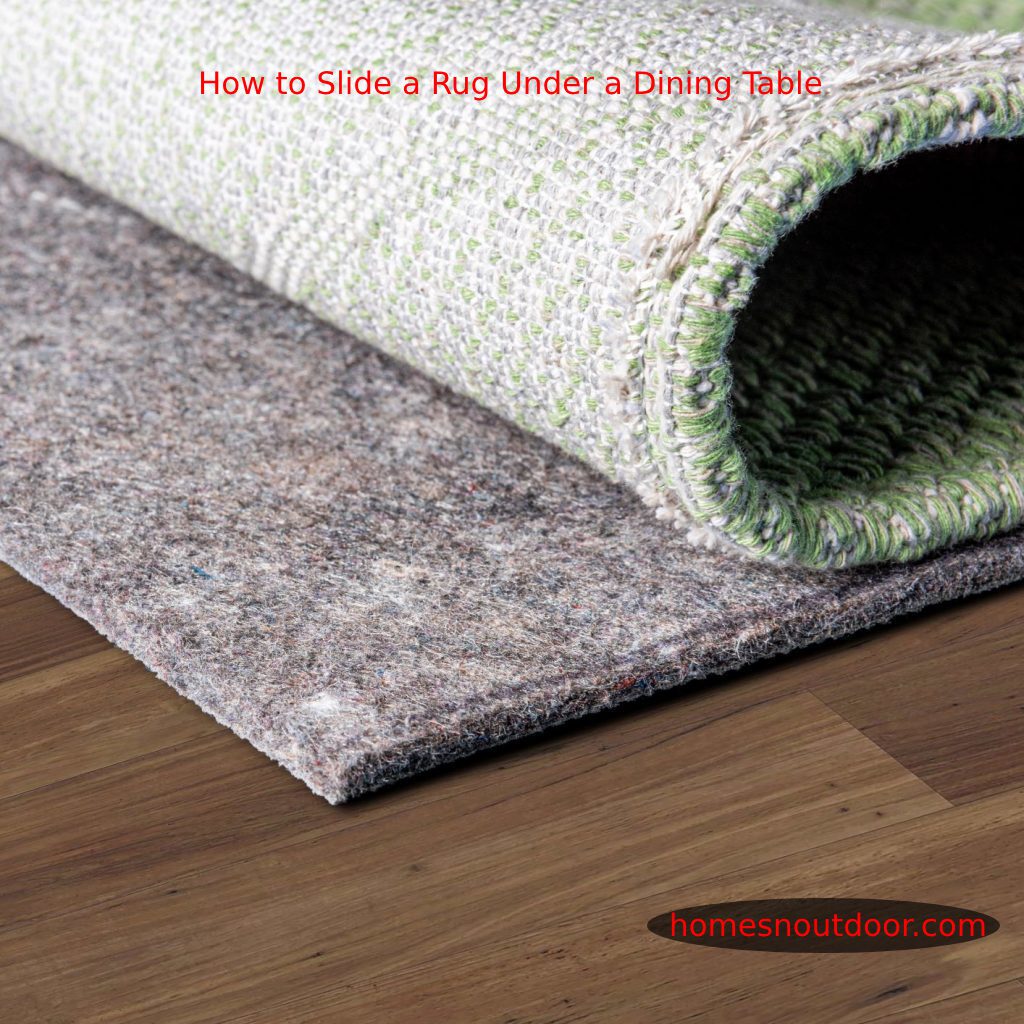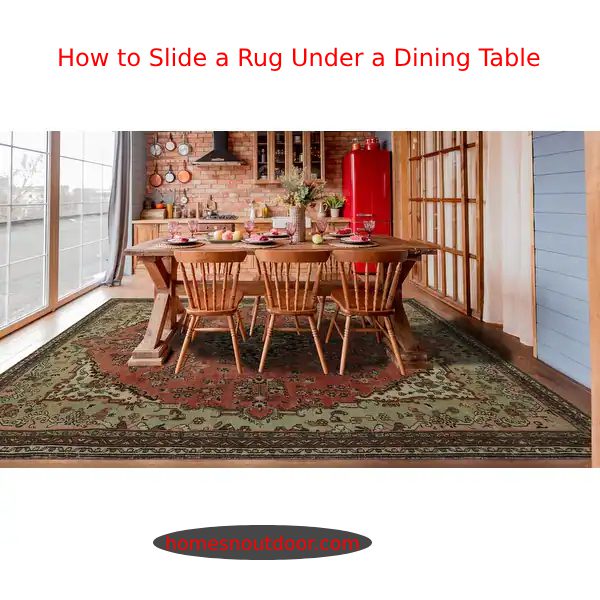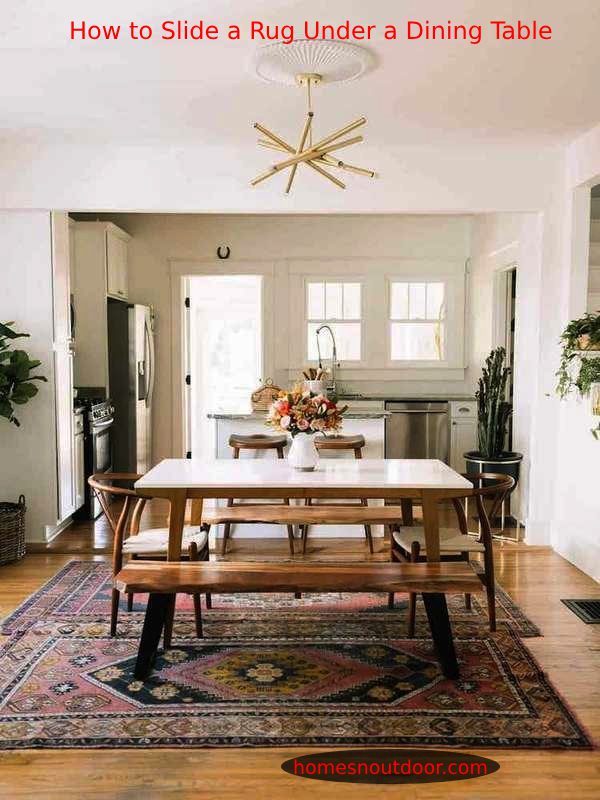To slide a rug under a dining table, tilt the table sideways and gently ease the rug into place. Ensure the rug is centered before setting the table down.
Positioning a rug under your dining table not only adds a touch of elegance to your dining area but also helps define the space and provide comfort underfoot. The process may seem daunting at first, but with a bit of technique, it becomes a simple task.
A well-placed rug brings together the aesthetic of your dining room, creating an inviting ambiance for family meals and social gatherings. The key is to choose the right size rug and manage the maneuver without disrupting your room’s set-up. This quick guide ensures that incorporating a rug into your dining area is both effortless and efficient, enhancing the overall look and feel of your space.


Introduction To Rug Placement
An expertly chosen and positioned rug can dramatically enhance the ambience and visual appeal of a dining room, anchoring the space and adding warmth and texture. A rug serves not only as a style statement but also provides practical benefits, such as noise reduction, comfort underfoot, and protection for your flooring. Before introducing a rug under a dining table, it’s crucial to consider the size, shape, material, and maintenance requirements to ensure a perfect and functional fit that complements your dining area’s aesthetics.
| Consideration | Details |
|---|---|
| Size | Should extend beyond the chairs when pulled out |
| Shape | Mirrors the shape of the table for cohesion |
| Material | Easy to clean, withstands frequent use |
| Maintenance | Regular cleaning, immediate stain management |
Choosing The Right Rug
Choosing the right rug for your dining area involves understanding the interplay between rug sizes and dining table dimensions. Ensure that the rug is sufficiently large to accommodate chairs even when they’re pulled out. A good rule of thumb is to select a rug that extends at least 24 inches beyond the table on all sides. This prevents chairs from catching on the edge of the rug and provides a balanced look.
Regarding material and texture choices, consider rugs made from durable and easy-to-clean fibers like polypropylene or wool, as these can withstand frequent foot traffic and potential spills. A flatweave or low-pile rug often works best for dining areas, offering ease of movement for chairs and simpler maintenance.
The style and design of the rug is equally important to create a cohesive dining room aesthetic. Aim for a rug that complements your room’s color scheme and decor style. Whether you prefer a muted tone to blend with your current decor or a bold pattern to make a statement, the right choice can tie the dining area together harmoniously.
Preparation For Rug Placement
Clearing the space around your dining table is a critical first step before introducing a rug into the area. Relocate chairs and any nearby furniture to create ample room for maneuvering. This allows for the rug to be placed without obstruction. Ensuring the floor beneath the dining table is thoroughly clean is equally vital, which involves sweeping, vacuuming, and mopping. A clean surface will prevent dirt from being trapped under the rug, thereby prolonging its cleanliness and durability.
Regarding the strategies for moving the dining table, safety should be your paramount concern. Enlist assistance if the table is heavy to prevent injury or damage. If the table is manageable, gently lift and slide it away from the intended rug area. A temporary resting spot should be designated to hold the table while the rug is being positioned.
Gathering necessary tools and materials is essential before beginning the rug placement. This includes a rug pad, tape measure, and possibly slider pads for furniture. The pad will prevent slipping and add cushioning, whereas the tape measure will ensure correct alignment and centering of the rug in relation to the table. If needed, use slider pads under the table legs to easily glide the table back over the rug without causing any damage to the floor or the rug itself.
Step-by-step Guide To Sliding The Rug
Aligning the corners and edges of a rug with your dining table is crucial for aesthetic symmetry and balance. Begin by determining the center point of your dining area to ensure an even distribution of the rug. Make sure that all four corners are equidistant from the center of the table. This creates a cohesive visual flow and anchors your dining space effectively.
Approaching the task of lifting and sliding furniture, it’s advisable to enlist the help of a friend or family member. Carefully lift each leg of the dining table — one at a time — and slide the rug underneath. You may use a furniture slider or a thick cloth to prevent damage to both the floor and the furniture legs. This technique reduces the risk of injury and ensures a controlled, smooth maneuver.
Upon positioning the rug, the final adjustments involve ensuring a smooth and even fit beneath the table. Take a moment to straighten out any creases or bumps on the surface of the rug. It’s vital to ensure the rug lies flat against the floor for both aesthetic impact and safety. As a final touch, make sure equal amounts of rug space extend beyond the table on all sides, permitting chairs to slide out comfortably without catching the rug’s edge.
Post-placement Considerations
Maintaining the position of your rug under the dining table is crucial to both its aesthetic appeal and functional stability. To achieve this, proper underlays are essential. These can be non-slip pads or rug grippers that prevent sliding and bunching. Adequate underlay not only secures the rug in place but also provides additional cushioning and extends the life of your rug by minimizing wear.
Keeping dining area rugs clean demands regular maintenance. Stains should be treated promptly with appropriate cleaners, and rugs should be vacuumed regularly to prevent crumbs and dirt from settling into the fibers. Consider professional cleaning once a year to maintain the rug’s hygiene and appearance.
Addressing common issues post-placement may involve repositioning the rug to balance wear, especially in high-traffic areas, or ensuring that the edges lay flat to avoid tripping hazards. Should the rug become wrinkled or bunched, straighten and stretch it out evenly from the center to the edges.

Credit: www.target.com
Alternative Methods And Additional Tips
Rug sliders are invaluable tools for maneuvering a rug beneath a dining table. Engage an extra pair of hands to lift and slide the rug smoothly. Ensure the table is evenly lifted, avoid dragging to prevent damage.
Sometimes, dining tables come with unique shapes or sizes that complicate the process. Innovative thinking might lead to tilting the table on its side or removing legs temporarily. Keep the rug’s orientation in mind to align it aesthetically with the room’s decor.
Seek professional input to tackle complex scenarios. They recommend high-quality rug pads to maintain position and prevent slippage. Emphasize on selecting the right size rug; it should be large enough to house all chairs comfortably, even when pulled out.


Frequently Asked Questions Of How To Slide A Rug Under A Dining Table
What Are The Rules For Putting A Rug Under A Dining Table?
Ensure your rug extends at least 24 inches beyond the table on all sides. This allows chairs to stay on the rug even when pulled out. Choose a durable rug to withstand frequent movement and potential spills. Avoid thick piles that trap crumbs and hinder chair movement.
How Do You Move A Rug By Yourself?
Roll the rug tightly from one end to help reduce its size. Secure it with rope or tape to prevent unrolling during movement. Gently lift the rug, using your legs to avoid back strain, and carry it to the new location.
Use a rug slider for easier transportation on smooth floors.
How Do I Keep My Rug From Bunching Under My Table?
To prevent your rug from bunching under a table, ensure it is the right size and choose a thick, non-slip pad. Flatten it out by placing heavy objects on the corners for some time. Regularly adjust and straighten the rug to maintain its position.
Do I Need A Rug Pad Under Dining Table?
Yes, a rug pad is recommended under a dining table to prevent slipping, protect the floor, and extend the rug’s life.
Conclusion
Sliding a rug under your dining table transforms mealtime aesthetics and comfort. Remember, alignment and size are key. Careful handling and appropriate tools ensure a smooth, wrinkle-free fit that enhances your dining area. Embrace this simple change, and relish your renewed space at your next gathering.

